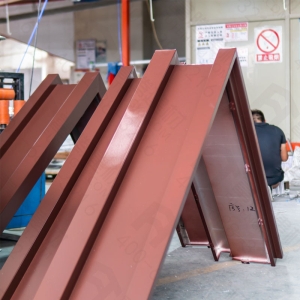In recent years, wood grain aluminum veneer has been widely used in the field of architectural decoration due to its unique decorative effect and superior performance. As an aluminum building material with imitation wood grain effect, it not only retains the advantages of aluminum such as lightness, corrosion resistance, and easy maintenance, but also has the natural texture and texture of wood, making it an ideal choice for modern architectural decoration. When purchasing wood grain aluminum veneer, thickness is a crucial indicator. Aluminum veneers of different thicknesses are suitable for different usage scenarios. This article will provide you with a detailed analysis of the thickness and related issues of wood grain aluminum veneers on the Shanghai market to help you make a more informed choice.
1. Common thickness of wood grain aluminum veneer
The thickness of wood grain aluminum veneer is usually selected according to specific application scenarios and usage requirements. Generally speaking, the thickness of common wood grain aluminum veneers on the market ranges from 1.5mm to 4.0mm, and the most commonly used thicknesses are 2.0mm and 3.0mm. Aluminum veneers of these thicknesses can meet the needs of most architectural decorations, and can show superior performance both indoors and outdoors.
1.5mm thickness: 1.5mm wood grain aluminum veneer is usually used for interior decoration. Due to its thin thickness and light weight, it is suitable for parts that do not bear gravity, such as ceilings and walls. It has a good decorative effect and is also relatively economical in cost.
2.0mm thickness: 2.0mm wood grain aluminum veneer is the most common specification on the market and is suitable for indoor and outdoor wall decoration. While ensuring the decorative effect, this thickness of aluminum veneer also has a certain strength and durability, and can cope with more complex use environments.
2.5mm thickness: 2.5mm wood grain aluminum veneer is suitable for some occasions with high requirements for strength and stability, such as shopping malls, stations and other public places with dense traffic. Its thickness is relatively moderate, with sufficient strength and not too bulky.
3.0mm thickness: 3.0mm wood grain aluminum veneer is often used in outdoor curtain walls and other parts that need to withstand certain external forces. Aluminum veneers of this thickness not only provide excellent decorative effects, but also have strong wind pressure resistance and weather resistance, suitable for long-term exposure to outdoor environments.
4.0mm thickness: 4.0mm wood grain aluminum veneers are suitable for large-scale construction projects, especially those that require ultra-high strength and durability. Aluminum veneers of this thickness are heavy and relatively expensive, but their stability and safety are unparalleled, making them ideal for curtain walls of high-rise buildings.
2. Selection basis for the thickness of wood grain aluminum veneers
When choosing the thickness of wood grain aluminum veneers, multiple factors need to be considered, including usage scenarios, load requirements, decorative effects, and budget constraints. Here are some selection criteria to help you make a better decision:
Use scenario: If it is used for interior decoration, thinner aluminum veneers are usually sufficient to meet the needs, such as 1.5mm or 2.0mm. If it is used outdoors, especially for parts such as curtain walls that need to withstand wind pressure and external forces, it is recommended to choose thicker aluminum veneers, such as 3.0mm or 4.0mm.
Bearing requirements: For occasions that need to bear a certain weight or external force, such as shopping malls, stations and other public places, thicker aluminum panels should be selected to ensure safety
 扫一扫 加微信好友了解更多
扫一扫 加微信好友了解更多




No. 3, Miaozikou Industrial Park, Shilou Town, Panyu District, Guangzhou.
400-688-3216
info@futengkj.com


